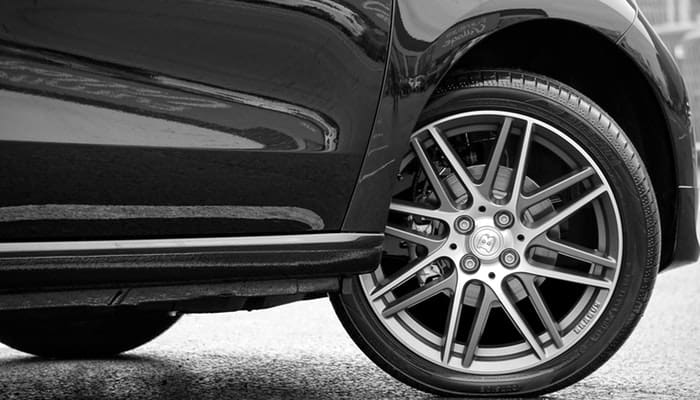This does not happen to all cars but sometimes, a vehicle may vibrate or shake a lot when the driver slowly steps on the brake pedal during the ride. Vibrations can be annoying or worrisome. Even though we are looking at a common car problem, it is still best to learn why there is vibration when braking a vehicle. With this knowledge, you can provide an immediate solution for it.
Major Components of the Brake System
The first step in knowing why there’s vibration when braking a car is getting familiar with the primary parts found in the brake system.
Tires
In order to have long-lasting tires, one way is to make sure that the wheels are perfectly aligned all the time. As soon as the car leaves the manufacturer for selling, its wheels are at the perfect right angle. This is to ensure that all wheels share equal responsibility while moving along the road. The car must only follow a straight line when you intend to drive straight. No wobbles are allowed.

We cannot stress this enough: it is important to schedule your own regular car maintenance. It is not even necessary to do heavy work during the process. Meticulous inspection is already sufficient to avoid serious car problems. And during the inspection, never forget about the wheels and tires.
Wheels
More about the wheels, we need to be familiar with their bearings and lug nuts. These specific components ensure that the wheels stay tight and secure for a consistently smooth ride. They support the hubs, tires and the whole wheel itself to provide uniform movement.
Brake Pads
Going deeper into the brake system, we have special pads to work with the rotors or drums. Using friction, brake pads turn kinetic energy to thermal. They are part of a specific type of brake called the disc system. As soon as you step on the brake pedal, hydraulics makes the caliper clamp its two pads and the moving rotor together to start slowing down or stopping the car.

Brake Drums or Rotors
The technical terms “rotor” and “drum” when we talk about the brake system are mainly based on your car’s model. Overall, drums and rotors are connected to the wheels. Starting from the part where you step on the brake pedal, the pads apply pressure onto the drums and rotors to slow down or stop the vehicle.
Reasons for Vibration When Braking a Car
To understand why there is vibration when braking a vehicle, we need to discuss the specific reasons by going back to the major components of the brake system:
Uneven Tires
Time, damaged suspension or misaligned wheels lead to the tires’ deterioration, which triggers vibration when braking a vehicle. The main culprits are actually the misaligned wheels because they make the tires go in awkward, uneven angles. Uneven tires are very noticeable when you start slowing down the car to a full stop. That’s when the vibrations come in. Aside from brake vibration, uneven tires can also make a harsh squealing sound when the car turns.
Wobbly Wheels
Loose lug nuts and wheel bearings lead to wobbly car movement, hence the vibrations. The shaky motion may not be triggered by fast movement because of the momentum. However, braking the car leads to the loss of momentum, making the wheels wobble or vibrate.
Warped Brake Pads
Distorted brake pads due to intense heat over time cannot immediately make contact with the rotors or drums, leading to inconsistency. The inconsistent movement of the brake system results to vibrations. Rust, debris, and dirt can also affect the pads smooth movement.
Warped Brake Drums or Rotors
Another distortion of the brake system due to heat and long-term use happens to rotors or drums. A warped rotor cannot make contact with the pads as a whole, so the effect is vibration when you use the brake pedal.
What to Do
There are three approaches to solve the issue of vibration when braking a vehicle:
Inspection
Before solving the problem, you need to know the root cause. Check if which rotors cause the vibration. You may know this by evaluating the shake or pulses. If you feel that the vibration comes from the steering wheel as you step on the brake, then the problem is found on the front rotors. Other internal problems can be detected just by focusing on the steering wheel, especially when it makes sounds such as clicks while you turn it. See, you must be an attentive driver to stop small problems from getting worse.
For the rear, the whole car must be shaking like crazy. It is possible that only one rotor causes the vibrations. So, you need to find the malfunctioning rotor carefully.
DIY
As long as you are a pro in doing mechanical work on your own, nothing is stopping you from solving the vibration issue yourself. If the reason is just a dirty rotor, then you can just turn it until a clean section shows up for a better contact with the brake pads. On the other hand, if the disc has a thin spot, then it needs replacement.
Loose lug nuts are the easiest to solve when it comes to fixing brake vibrations. Just use a wrench to tighten the nuts. Another easy DIY solution is changing the tires after making sure that the wheels are aligned once more. You might be surprised how easy it is to learn to change tires.
Seek Help
Some brake vibration-related issues such as misaligned wheels and damaged pads can be hard to handle for novice car owners. Of course, let’s not forget about professional mechanics that can help anyone with any car problem. All you need to do is just choose a reliable auto shop or mechanic based on your budget.

Summary
Like any problem, solving a car issue on your own such as vibration when braking a vehicle relies on understanding the causes first. Sure, you can put all the responsibility on a mechanic if you prefer professional help but with basic knowledge regarding the brake system, you can avoid being fooled by greedy mechanics and prevent further problems in the future.











